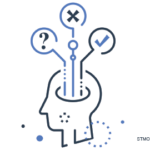Heuristics
We must understand how our minds function during times of uncertainty. In their now-famous analysis, Amos Tversky and Daniel Kahneman outlined the ways biases and heuristics affect our judgment during times of uncertainty.2 Heuristics, originating from the Greek word for discover, are methods or rules used to aid problem solving in the face of complex problems or incomplete information. We all use heuristics, often without realizing it, when making decisions. Tversky and Kahneman described how, when trying to assess uncertain probabilities (such as the likelihood a patient has lupus), we often use heuristics that, while at times can be valuable, can also lead to systematic errors.
Recognition of such biases in medical decision making has become more commonplace, with such terms as representativeness, availability and anchoring heuristics now more prevalent than ever in our lexicon. Understanding the ways heuristics can lead to cognitive errors is even more crucial for rheumatologists given the greater extent to which we operate under conditions of uncertainty.
One gets the feeling the tendency to make medical decisions under the effect of heuristics is ubiquitous in rheumatology practice—and with good reason; it is a natural part of the way our minds process data. We may be led to a rare diagnosis by recalling a familiar case we recently saw, falling prey to the availability heuristic. One can imagine how this may aid us in making a good medical decision, but also how it may lead us to the error of missing a much more common condition. How often do we suspect a treatment may work based on a previous experience in which it was successful, although data may suggest the treatment is not as effective as our bias suggests? We may overlook an alternative option due to the representativeness heuristic.
Acknowledging the impact biases have on us is important at all levels of practice, and early in one’s rheumatology career may be the best time to start.
Coping Tips
During an interview for fellowship I was asked how I would deal with not knowing the answers. My green answer was that good communication with patients and shared decision making would be my coping mechanisms. This strategy has been important, but I have come to learn that unraveling uncertainty is a more complex task, full of the emotional and cognitive pitfalls outlined above. It might prove fruitful to incorporate mechanisms for dealing with uncertainty and our cognitive biases into training.
Reflection is one way to tackle the emotional aspect. A rheumatology case conference can quickly turn into a heated debate due to all the differing opinions, but we rarely have time to reflect at the end on how we feel about not knowing the answer and about how we bridge this gap with our patients. Structured time for reflection may help trainees process these dilemmas with more ease.
Modeling by mentors is another method by which we learn how to have challenging, uncertainty-laden conversations with patients, but feedback and discussion about these interactions could further instill in trainees the skills to thrive in such situations.
In addition, training in cognitive biases could also be useful. Reilly et al. described a curriculum-based intervention that improved internal medicine residents’ knowledge and recognition of cognitive biases.3
During fellowship, we are informally taught good habits to avoid some of the common pitfalls in medical decision making, but building this type of education into formal curriculum could prepare trainees to more readily recognize heuristics during their careers as rheumatologists.

